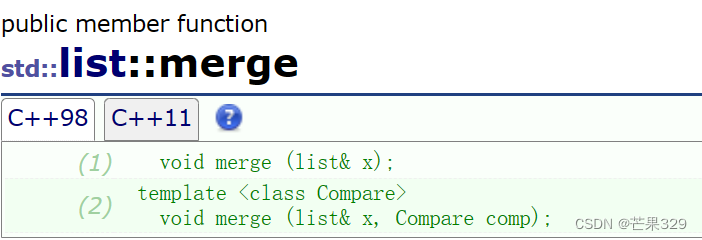本文主要是介绍【C++第十课 - List】List的使用、list底层实现、list的const迭代器实现,希望对大家解决编程问题提供一定的参考价值,需要的开发者们随着小编来一起学习吧!
目录
- 一、List的使用
- 构造函数
- 1、遍历
- 2、reverse
- 3、merge
- 4、unique
- 5、sort
- 6、remove
- 7、splice
- 二、底层实现
- 2、迭代器
- 3、迭代器的补充
- 4、insert
- 5、push_front
- 6、erase
- 7、析构和clear
- 8、拷贝构造
- 9、赋值=
- 10、const迭代器
- 11、反向迭代器
一、List的使用
补充
需要使用类域指向的:
1、内部类
2、类里面typedef的
构造函数
(1)构造一个空的list
(2)构造一个list,它里面的数据是n个val
(3)用迭代区间构造list
(4)用已有的一个list构造另一个list
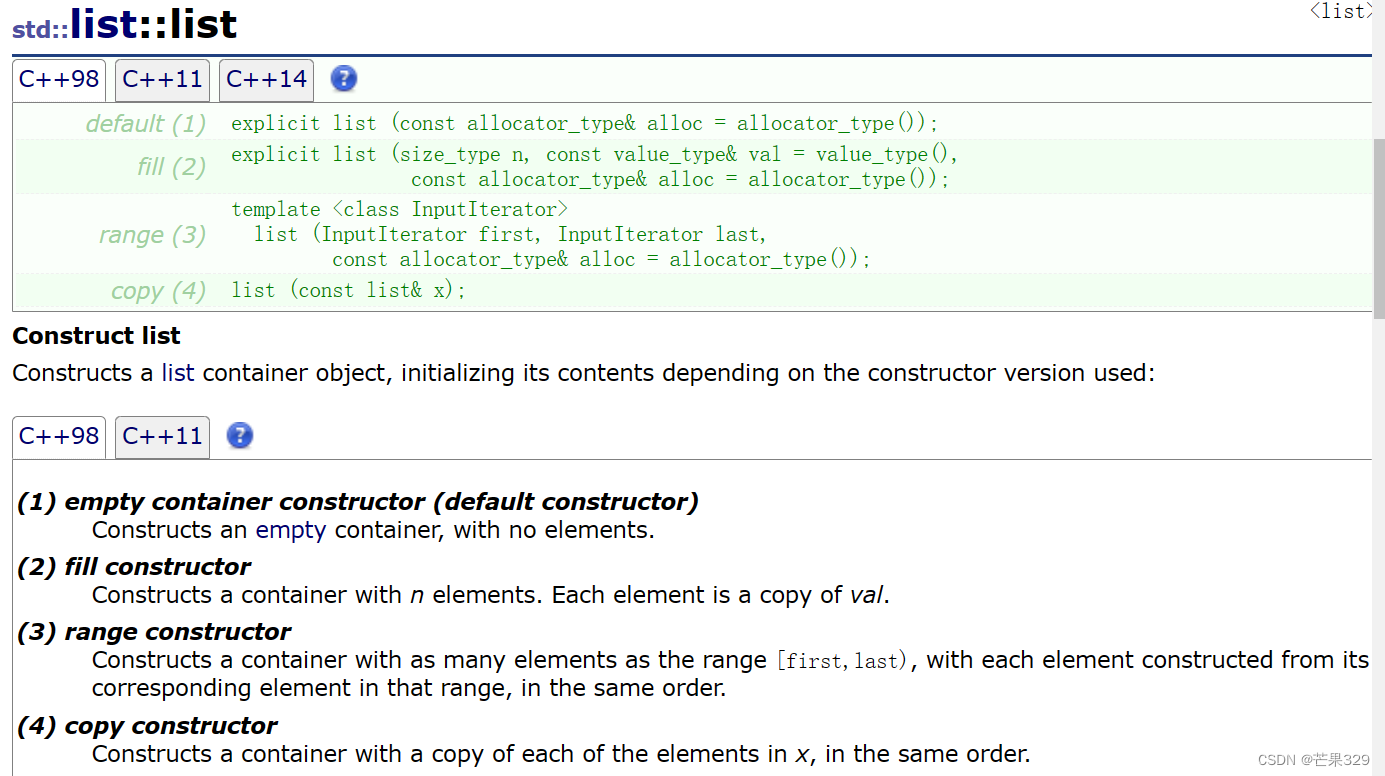
List就是一个带头双向循环列表
List不支持[]
没有扩容什么的概念了
1、遍历
(1)迭代器
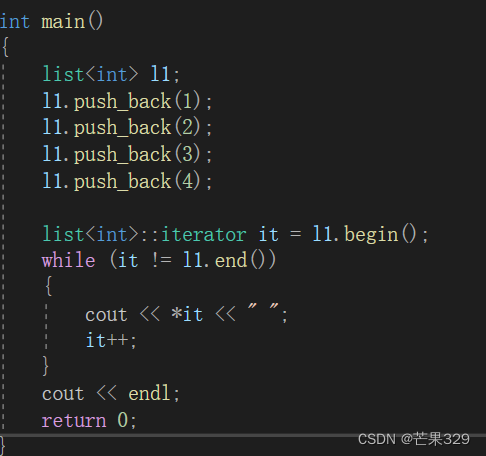

(2)范围for
但范围for的底层和迭代器没有区别
list<double> l2(5, 6.6);for (auto e : l2){cout << e << " ";}cout << endl;

2、reverse
逆置
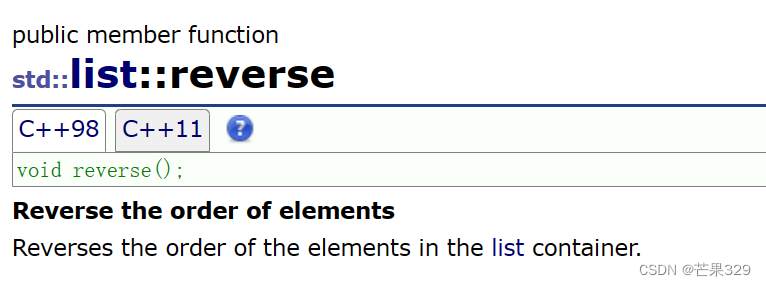
list<int> l1;l1.push_back(1);l1.push_back(2);l1.push_back(3);l1.push_back(4);list<int>::iterator it = l1.begin();while (it != l1.end()){cout << *it << " ";it++;}cout << endl;l1.reverse();for (auto e : l1){cout << e << " ";}cout << endl;

3、merge
归并:将两个有序的列表归并成一个有序的
使用merge的时候,可以先对列表进行sort排序
void test2()
{list<int> l1;l1.push_back(3);l1.push_back(5);l1.push_back(2);l1.push_back(9);l1.sort();for (auto e : l1){cout << e << " ";}cout << endl;list<int> l2;l2.push_back(13);l2.push_back(15);l2.push_back(22);l2.push_back(19);l2.sort();for (auto e : l2){cout << e << " ";}cout << endl;l1.merge(l2);for (auto e : l1){cout << e << " ";}cout << endl;
}

4、unique
去重:一般要求有序,无序必须相同的值是挨着的

void test3()
{list<int> l1;l1.push_back(3);l1.push_back(5);l1.push_back(2);l1.push_back(9);l1.push_back(2);l1.push_back(2);l1.push_back(9);l1.sort();for (auto e : l1){cout << e << " ";}cout << endl;l1.unique();for (auto e : l1){cout << e << " ";}cout << endl;
}

5、sort
排序
list不能用算法库里面的sort,算法库里面的sort是快排(需要连续的空间,原地排序,不稳地排序,O(n2)),list自带的sort是归并(稳定排序,O(nlogn))
vector的排序用的是递归
实际中排序:拷贝到vector,进行排序,排完再assign到list里面

6、remove
相当于先find再删

void test4()
{list<int> l1;l1.push_back(3);l1.push_back(5);l1.push_back(2);l1.push_back(100);l1.push_back(9);for (auto e : l1){cout << e << " ";}cout << endl;l1.remove(100);for (auto e : l1){cout << e << " ";}cout << endl;
}

7、splice
把一个链表的值转移到另一个链表,是把一个链接里面的节点直接拿走

void test5()
{list<int> l1;l1.push_back(3);l1.push_back(5);l1.push_back(2);l1.push_back(100);l1.push_back(9);cout << "l1:";for (auto e : l1){cout << e << " ";}cout << endl;list<int> l2;l2.push_back(13);l2.push_back(15);l2.push_back(22);l2.push_back(19);cout << "l2:";for (auto e : l2){cout << e << " ";}cout << endl;l1.splice(l1.begin(), l2);cout << "l1:";for (auto e : l1){cout << e << " ";}cout << endl;cout << "l2:";for (auto e : l2){cout << e << " ";}cout << endl;
}

二、底层实现
1、带头双向循环列表
struct和class的区别
(1)继承权限:struct默认为public,而class默认的为private。
(2)访问权限:struct默认的成员变量访问控制权限是public,而class默认的成员变量访问权限则为private。
(3)class可以用于定于template,struct不能。
列表节点的定义
template<class T>struct ListNode {ListNode(const T& x = T()):_prev(nullptr),_next(nullptr),_data(x){}ListNode<T>* _prev;ListNode<T>* _next;T _data;};
列表的定义
template<class T>class list{public:typedef ListNode<T> Node;typedef __listiterator<T> iterator;list(){_head = new Node;_head->_prev = _head;_head->_next = _head;}void push_back(const T& x){Node* tmp = new Node(x);Node* tail = _head->_prev;tail->_next = tmp;tmp->_prev = tail;_head->_prev = tmp;tmp->_next = _head;}private:Node* _head;};
2、迭代器
Node是自定义类型,但Node*是内置类型,是要改变的是Node*的指向,不能改变指针的运算符
对Node*类型进行运算符重载,但Node*是内置类型无法运算符重载,因此需要套一个类__listiterator
namespace zyh
{template<class T>struct ListNode {ListNode(const T& x = T()):_prev(nullptr),_next(nullptr),_data(x){}ListNode<T>* _prev;ListNode<T>* _next;T _data;};template<class T>struct __listiterator{typedef ListNode<T> Node;typedef __listiterator self;Node* _node;__listiterator(Node* node):_node(node){}self& operator++(){_node = _node->_next;return *this;}bool operator!=(const self& x){return _node != x._node;}T operator*(){return _node->_data;}};template<class T>class list{public:typedef ListNode<T> Node;typedef __listiterator<T> iterator;list(){_head = new Node;_head->_prev = _head;_head->_next = _head;}void push_back(const T& x){Node* tmp = new Node(x);Node* tail = _head->_prev;tail->_next = tmp;tmp->_prev = tail;_head->_prev = tmp;tmp->_next = _head;}iterator begin(){//return iterator(_head->_next);return _head->_next;}iterator end(){return _head;}private:Node* _head;};void list_test1(){list<int> lt1;lt1.push_back(10);lt1.push_back(1);lt1.push_back(2);lt1.push_back(9);lt1.push_back(3);list<int>::iterator it = lt1.begin();while (it != lt1.end()){cout << *it << " ";++it;}cout << endl;}
}

3、迭代器的补充
这些都是在__listiterator类里面
(1)前置++:self& operator++()
self& operator++(){_node = _node->_next;return *this;}
(2)后置++:self& operator++(int)
self& operator++(int){//Node* tmp = _node;self tmp(*this);_node = _node->_next;return tmp;(3)前置- -:self& operator--()
self& operator--(){_node = _node->_prev;return *this;}
(3)后置- -:self& operator--(int)
self& operator--(int){Node* tmp = _node;_node = _node->_prev;return tmp;}
迭代器这个类里面没有析构函数
默认的析构函数对类里面的成员是不做处理的
这个类里面没有写析构函数,是因为这个类只是listnode的节点给它访问,他不能把人家删除吧
4、insert
不存在迭代器失效的问题
void insert(const iterator pos, const T& x){Node* tmp = new Node(x);Node* forward = (pos._node)->_prev;forward->_next = tmp;tmp->_prev = forward;tmp->_next = pos._node;(pos._node)->_prev = tmp;}
5、push_front
不存在迭代器失效问题
iterator push_front(const T& x){Node* tmp = new Node(x);tmp->_next = begin();tmp->_prev = end();end()._node->_next = tmp;begin()._node->_prev = tmp;return tmp;}
6、erase
pos迭代器失效问题
iterator erase(iterator& pos){assert(pos != end());Node* prev = pos._node->_prev;Node* next = pos._node->_next;delete pos._node;prev->_next = next;next->_prev = prev;return next;}
7、析构和clear
析构:列表的所以节点要释放,哨兵位的头节点也要释放
clear:只释放列表的所以节点,哨兵位的头节点不释放
clear
bool empty(){if (_head->_next == _head->_prev)return true;elsereturn false;}void clear(){if (empty())return;Node* cur = _head->_next;while (cur != _head){Node* prev = cur->_prev;Node* next = cur->_next;prev->_next = next;next->_prev = prev;delete cur;cur = next;}}
问题:写的过于复杂,可以复用erase
void clear(){iterator it = begin();while (it != end()){it = erase(it);}}
注意:
it = erase(it)这里一定要再赋值给it,因为erase之后的it就是失效了
析构
~list(){clear();delete _head;_head = nullptr;}
8、拷贝构造
没有加const迭代器
//list(const list<T>& x)list(list<T>& x){_head = new Node;_head->_prev = _head;_head->_next = _head;iterator it = x.begin();while (it != x.end()){push_back(*it);++it;}}
9、赋值=
list<T>& operator=(list<T> lt){swap(lt);return *this;}
10、const迭代器
传参的时候会有const的对象
const迭代器不是自身不能修改,是指向的内容不能被修改
const迭代器不是const对象,自己可以修改
const迭代器 - 第一版
与普通迭代不同的地方
__const_listiterator类里面

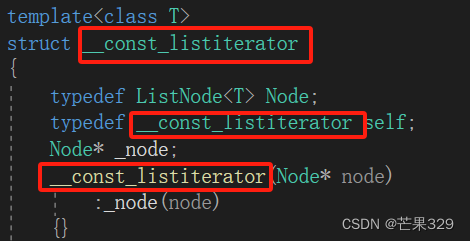
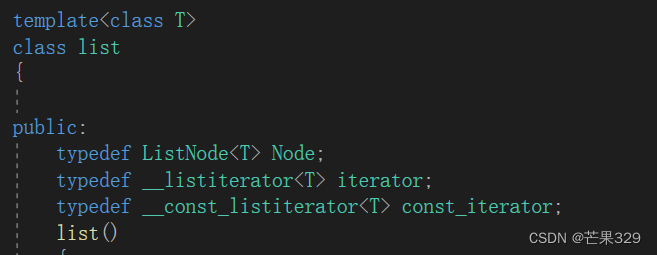
template<class T>struct __const_listiterator{typedef ListNode<T> Node;typedef __const_listiterator self;Node* _node;__const_listiterator(Node* node):_node(node){}self& operator++(){_node = _node->_next;return *this;}self& operator++(int){//Node* tmp = _node;self tmp(*this);_node = _node->_next;return tmp;}bool operator!=(const self& x){return _node != x._node;}const T& operator*(){return _node->_data;}self& operator--(){_node = _node->_prev;return *this;}self& operator--(int){Node* tmp = _node;_node = _node->_prev;return tmp;}};
list类里面
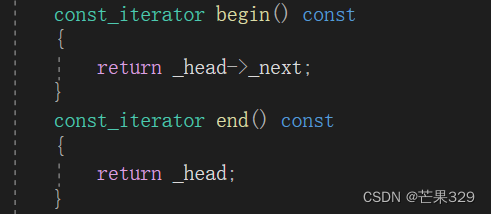
template<class T>class list{public:typedef ListNode<T> Node;typedef __listiterator<T> iterator;typedef __const_listiterator<T> const_iterator;list(){_head = new Node;_head->_prev = _head;_head->_next = _head;}//list(const list<T>& x)list(list<T>& x){_head = new Node;_head->_prev = _head;_head->_next = _head;iterator it = x.begin();while (it != x.end()){push_back(*it);++it;}}list<T>& operator=(list<T> lt){swap(lt);return *this;}void push_back(const T& x){Node* tmp = new Node(x);Node* tail = _head->_prev;tail->_next = tmp;tmp->_prev = tail;_head->_prev = tmp;tmp->_next = _head;}iterator begin(){//return iterator(_head->_next);return _head->_next;}iterator end(){return _head;}const_iterator begin() const{return _head->_next;}const_iterator end() const{return _head;}iterator insert(const iterator pos, const T& x){Node* tmp = new Node(x);Node* forward = (pos._node)->_prev;forward->_next = tmp;tmp->_prev = forward;tmp->_next = pos._node;(pos._node)->_prev = tmp;return tmp;}//iterator push_front(const T& x)//{// Node* tmp = new Node(x);// tmp->_next = begin();// tmp->_prev = end();// end()._node->_next = tmp;// begin()._node->_prev = tmp;// return tmp;//}iterator push_front(const T& x){return insert(begin(), x);}iterator erase(iterator pos){assert(pos != end());Node* prev = pos._node->_prev;Node* next = pos._node->_next;delete pos._node;prev->_next = next;next->_prev = prev;return next;}iterator pop_back(){return erase(--end());}iterator pop_front(){return erase(begin());}bool empty(){if (_head->_next == _head->_prev)return true;elsereturn false;}//void clear()//{// if (empty())// return;// Node* cur = _head->_next;// while (cur != _head)// {// Node* prev = cur->_prev;// Node* next = cur->_next;// prev->_next = next;// next->_prev = prev;// delete cur;// cur = next;// }//}void clear(){iterator it = begin();while (it != end()){it = erase(it);}}~list(){clear();delete _head;_head = nullptr;}private:Node* _head;};
问题:迭代器的类和const迭代器的类两个类有点冗余
const迭代器 - 第二版
template<class T, class Ref>struct __listiterator{typedef ListNode<T> Node;typedef __listiterator self;Node* _node;__listiterator(Node* node):_node(node){}self& operator++(){_node = _node->_next;return *this;}self& operator++(int){//Node* tmp = _node;self tmp(*this);_node = _node->_next;return tmp;}bool operator!=(const self& x){return _node != x._node;}Ref operator*(){return _node->_data;}self& operator--(){_node = _node->_prev;return *this;}self& operator--(int){Node* tmp = _node;_node = _node->_prev;return tmp;}};
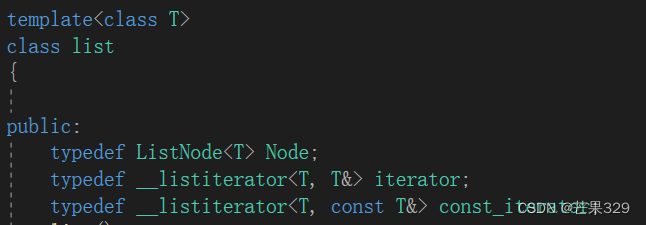
在const迭代器中实现->的运算符重载
当ListNode里面的data是个结构体时,使用->进行访问
11、反向迭代器
这篇关于【C++第十课 - List】List的使用、list底层实现、list的const迭代器实现的文章就介绍到这儿,希望我们推荐的文章对编程师们有所帮助!
